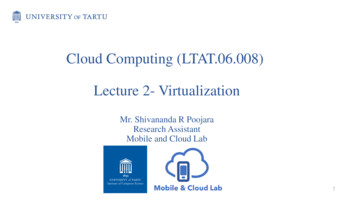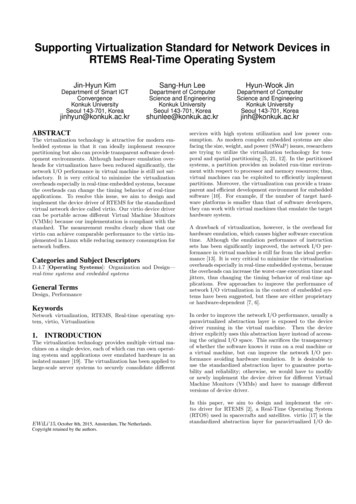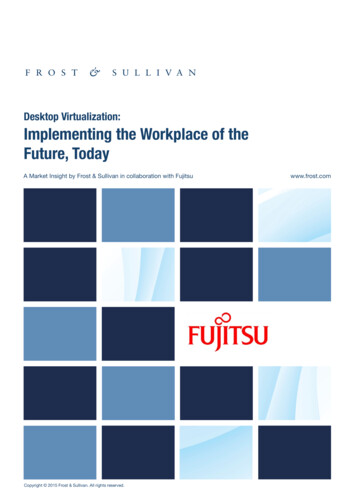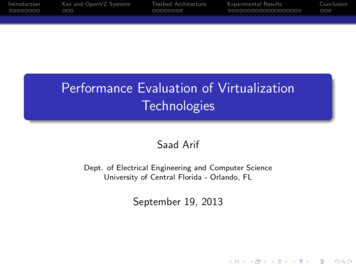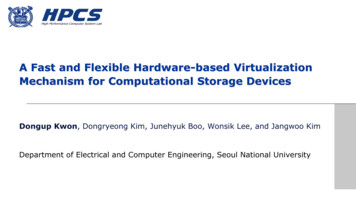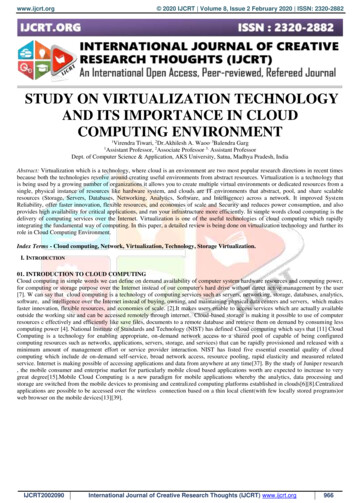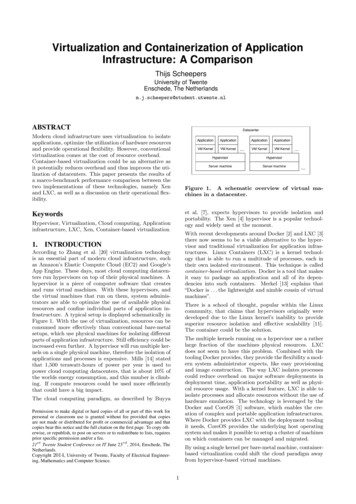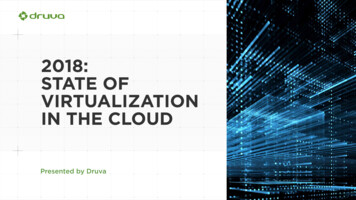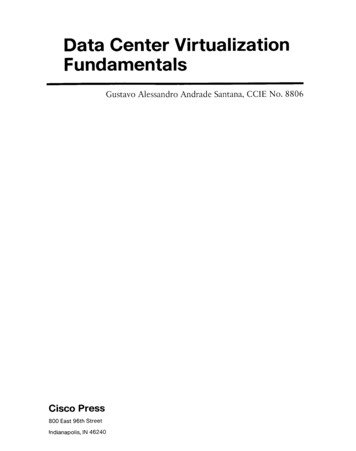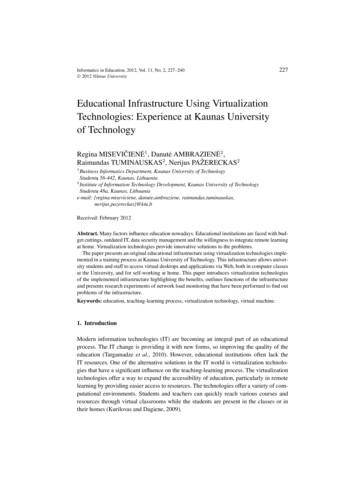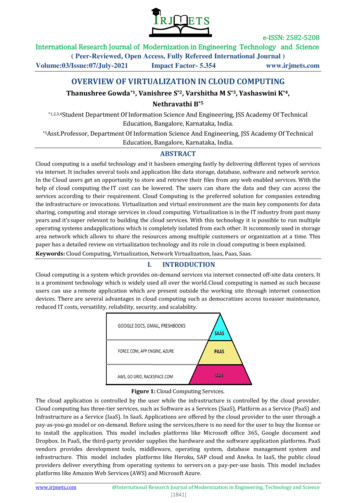
Transcription
e-ISSN: 2582-5208International Research Journal of Modernization in Engineering Technology and Science( Peer-Reviewed, Open Access, Fully Refereed International Journal )Volume:03/Issue:07/July-2021Impact Factor- 5.354www.irjmets.comOVERVIEW OF VIRTUALIZATION IN CLOUD COMPUTINGThanushree Gowda*1, Vanishree S*2, Varshitha M S*3, Yashaswini K*4,Nethravathi B*5*1,2,3,4StudentDepartment Of Information Science And Engineering, JSS Academy Of TechnicalEducation, Bangalore, Karnataka, India.*5Asst.Professor,Department Of Information Science And Engineering, JSS Academy Of TechnicalEducation, Bangalore, Karnataka, India.ABSTRACTCloud computing is a useful technology and it has been emerging fastly by delivering different types of servicesvia internet. It includes several tools and application like data storage, database, software and network service.In the Cloud users get an opportunity to store and retrieve their files from any web enabled services. With thehelp of cloud computing the IT cost can be lowered. The users can share the data and they can access theservices according to their requirement. Cloud Computing is the preferred solution for companies extendingthe infrastructure or invocations. Virtualization and virtual environment are the main key components for datasharing, computing and storage services in cloud computing. Virtualization is in the IT industry from past manyyears and it's super relevant to building the cloud services. With this technology it is possible to run multipleoperating systems andapplications which is completely isolated from each other. It is commonly used in storagearea network which allows to share the resources among multiple customers or organization at a time. Thispaper has a detailed review on virtualization technology and its role in cloud computing is been explained.Keywords: Cloud Computing, Virtualization, Network Virtualization, Iaas, Paas, Saas.I.INTRODUCTIONCloud computing is a system which provides on-demand services via internet connected off-site data centers. Itis a prominent technology which is widely used all over the world. Cloud computing is named as such becauseusers can use a remote application which are present outside the working site through internet connectiondevices. There are several advantages in cloud computing such as democratizes access to easier maintenance,reduced IT costs, versatility, reliability, security, and scalability.Figure 1: Cloud Computing Services.The cloud application is controlled by the user while the infrastructure is controlled by the cloud provider.Cloud computing has three-tier services, such as Software as a Services (SaaS), Platform as a Service (PaaS) andInfrastructure as a Service (IaaS). In SaaS, Applications are offered by the cloud provider to the user through apay-as-you-go model or on-demand. Before using the services,there is no need for the user to buy the license orto install the application. This model includes platforms like Microsoft office 365, Google document andDropbox. In PaaS, the third-party provider supplies the hardware and the software application platforms. PaaSvendors provides development tools, middleware, operating system, database management system andinfrastructure. This model includes platforms like Heroku, SAP cloud and Aneka. In IaaS, the public cloudproviders deliver everything from operating systems to servers on a pay-per-use basis. This model includesplatforms like Amazon Web Services (AWS) and Microsoft Azure.www.irjmets.com@International Research Journal of Modernization in Engineering, Technology and Science[1841]
e-ISSN: 2582-5208International Research Journal of Modernization in Engineering Technology and Science( Peer-Reviewed, Open Access, Fully Refereed International Journal )Volume:03/Issue:07/July-2021Impact Factor- 5.354www.irjmets.comCloud Deployment model has four types namely Public cloud, Private cloud, Community cloud and Hybrid cloud.The Public cloud provides both services and infrastructure which are shared by all customers and it is lesssecure. The Private cloud infrastructure is used by a single organization. It is also called as corporate model orinternal model. The server can be hosted on the premises of the owner company or it can be doneexternally andit is considered as more secure. Community cloud is the hybrid form of the private cloud. Community cloudenables services and systems which are shared by several organizations with shared common interest. It ismanaged by a third-party or an organization. The composition of public cloud and private cloud is called hybridcloud. Cloud computing has five vital characteristics, they are On-demand self-service, Broad network access,Resource pooling, Rapid elasticity and Measured service.Figure 2: Types of Cloud ComputingVirtualization plays a major role in cloud computing. Virtualization allows single machine to run multipleplatforms simultaneously. so, virtualization enables us to use same computer to work on various environment.In virtualization all virtual environments is arranged to ensure its own security and integrity. Virtual Machine isthe one which enables to run multiple platforms in the single machine concurrently. Virtual machine is createdusing both hardware and software engineering. Cloud computing system is bringing a tremendous fundamentalchange in Information Technology. Virtualization improves capacity and lowers the cost of IT infrastructure incloud computing.Virtualization technology provides an abstract environment about the underlying resources and simplifies theiruse, supports replication and separates users from one another, which increases elasticity of the system. Thecloud often includes virtualization software which manipulates the hardware as a part of their service package.With the help of virtualization multiple operating system and applications can run at a single time on the samemachine and a same hardware,by this we can increase the flexibility of the hardware.II.ROLE OF VIRTUALIZATIONVirtualization plays significant role in cloud computing, which helps to use one system separately by multipleusers. This technique is done by giving a logical name to all the physical resources and based on demand itprovides a pointer to those physical resources. To share data and information virtualization technique is veryimportant in cloud. From underlying hardware virtual machine is logically separated. A machine called host bywhich the virtual machine is created and this virtual machine is known as guest machine. The hypervisor is afirmware which user a combination of different types hardware virtualization. The main objective ofvirtualization isimprovement in security, energy saving, flexibility andreduction in cost.III.HISTORY OF VIRTUALIZATIONConcept of virtualization was first introduced in late 1950s. Since there were no personal computers at thattime virtualization did not become successful until 1990s. IT companies realized that they could save moneyand time by moving from physical to virtual environment. In 1964 IBM began to explore virtualization onmainframes, it released an operating system called VM running on mainframes 1972. In the development ofrobust time-sharing solution system IBM had invested a lot of effort and in 1999 VMware is launched.In 2004 Intel engineers began adding hardware virtualization support to Xen to prepare the necessary softwarewww.irjmets.com@International Research Journal of Modernization in Engineering, Technology and Science[1842]
e-ISSN: 2582-5208International Research Journal of Modernization in Engineering Technology and Science( Peer-Reviewed, Open Access, Fully Refereed International Journal )Volume:03/Issue:07/July-2021Impact Factor- 5.354www.irjmets.comfor the upcoming new processor. Under their efforts Xen 3.0 was released in 2005, which began to officiallysupport Intel’s VT technology. Between 2006 and 2010 major traditional IT vendors introduced their ownproducts in terms of virtualization. In 2007 HP introduced HP-UX Integrity virtual machines and Microsoftjoined Hyper-v in Windows Server in 2008. Since then, virtualization has become very successful in today’s ITworld.IV.TYPES OF VIRTUALIZATIONS IN CLOUD COMPUTINGFigure 3: Types of Virtualization1. Network Virtualization:Network virtualization helps user to create multiple individual networks from one physical area network (LAN).In this type of virtualization, all physical networking tools and other resources are combined into a singlesoftware-based resource. Network virtualization improves overall network’s productivity and efficiency,flexibility, reliability, security and scalability. Few examples of network virtualization are JunosV App Engine,Cisco Nexus and 6WIND Virtual Accelerator.2. Storage Virtualization:A virtual storage system manages multiple physical storage arrays which appears to be a single storage device.The resources needed can be increased by the centralized virtual storage system by increasing availability andflexibility. This virtualization software provides various advantages such as maintaining smooth operation,better work flow is created, downtime is reduced, load balancing, cheaper storage and the performance andspeed are better optimized. Few examples for storage virtualization are the transitional of physical diskaddress: CHS—Cylinders, Heads and sectors—addresses and Logical Block Addresses (LBAs), logical unitnumber andRAID groups.3. Server Virtualization:In Server virtualization’ masking of server resources takes place. Instead of assigning one task to one server, inserver virtualization multiple tasks run from one server. This causes an increase in performance and theoperating cost is reduced. Few examples of server virtualization are FreeVPS, LinuxVserver and OpenVZ.4. Data Virtualization:In Data virtualization, data is collected from various sources and it manipulates, segregates, delivers andretrieves data without any data specification. The on-demand integration is delivered to the users by using datavirtualization, which also removes latency. The technical details of the data are arranged logically so that itsvirtual view can be accessed by its interested people and users through various cloud services remotely. Fewexamples of data virtualization are JBoss, TIBCO Data Virtualization and Denodo.5. Desktop Virtualization:The other name for this type of virtualization is client-server computing model. Desktop virtualization enablesto store the users’ operating system on a server in a data center (this basically gives someone an entirecomputing platform without the hardware). Through this type of virtualization, employees can workconveniently from their homes. The data transfer is secured, and any risk of data theft is minimized. Fewwww.irjmets.com@International Research Journal of Modernization in Engineering, Technology and Science[1843]
e-ISSN: 2582-5208International Research Journal of Modernization in Engineering Technology and Science( Peer-Reviewed, Open Access, Fully Refereed International Journal )Volume:03/Issue:07/July-2021Impact Factor- 5.354www.irjmets.comexamples of desktop virtualization are VMware ThinApps Citrix XenApps, VMware View and Microsoft RemoteDesktop Services.6. Application Virtualization:Application virtualization helps a user to run an application on a computer, without relying on the computerhardware or software. Updating, maintaining and fixing the applications will be easier for an organization byusing application virtualization. Admin without entering in to the user’s desktop, they can modify and controlaccess permissions to the application. Another benefit of this type of virtualization is portability. Few examplesof application virtualization are XenApp, VM Thinapp, Zenworks and Microsoft App-V.V. BENEFITS OF VIRTUALIZATIONVirtualization reduces work load.Virtualization is cost predictable and it is cheaper.Whenever there is a need for more resources, it can be obtained from available pool of resources and thisis known as scalability.It promotes digital entrepreneurship and offers a better uptime.Through virtualization the managing of resources is mucheasier.Virtualized infrastructure can prevent entire system fromfailure. Virtualization allows automatic update to both hardwares and softwares by installing on their third-partyprovider. It improves the efficiency of the resources in the virtualenvironment. The energy can be used efficiently through virtualization. The IT operations can be done more smoothly. There is an easy transfer of machine or data. Faster deployment of resources can be done whenvirtualization is being used.VI.DRAWBACKS OF VIRTUALIZATION The cost of implementation can be very high and may requirepowerful machine.The scalability issue is created.Several links in chain is required which must work together cohesively.Virtualize environment is often questioned for data security since the servers are managed by third partyproviders. Virtualization takes time – It costs uses time over the long runwhen compared to local system. Some IT infrastructures might not be compatible with virtualized solution since all servers and applicationare not virtualization friendly. There is a issue of availability when virtualized servers go offline and every website they host would alsofail.VII.RELATED WORKSIn [1], The Developments and Trends related to virtualization is proposed. The published papers in reputablemagazines are examined and the trends in cloud virtualization is identified in this paper. In [2], Virtualizationtechnology and its importance in cloud computing is studied and a detailed review on role of virtualization ispresented in his paper. In [3], Virtualization security, its requirements and its solutions for cloud computingservice is addressed in this paper. In [4], Virtualization in CloudComputing is discussed. This paper also explainsabout virtualization, benefits, future scope and its challenges. In [5], Challenges on Virtualization Security inCloud Computing Environment is proposed. This paper addresses about providing security to virtualization layerby using several security vulnerabilities and various algorithms.In [6], A detailed study on virtualization and its concerns in cloud is done. In [7], A detailed review on opensource techniques used in virtualization, its challenges and the future scope is explained. It also focuses on theimprovement of elasticity of the resources using virtualization. In [8], Explained on Virtualization NetworkSecurity in the field of Cloud Computing. The main focal point is on Cloud Network Security. It discusses aboutwww.irjmets.com@International Research Journal of Modernization in Engineering, Technology and Science[1844]
e-ISSN: 2582-5208International Research Journal of Modernization in Engineering Technology and Science( Peer-Reviewed, Open Access, Fully Refereed International Journal )Volume:03/Issue:07/July-2021Impact Factor- 5.354www.irjmets.comthe benefits of cloud computing. In [9], Research and representation on the topic of Virtualization Technology inthe field of Cloud Computing. In this paper the cloud computing platform architecture based uponvirtualizationis put forward and also performance estimation inserver virtualization is discussed.VIII.CONCLUSIONOne of the most emerged technology in IT industry is cloud computing. It is used for various number ofactivities but conspicuous among them are storage and computation. Cloud computing is secured if and only ifvirtual machines are secured. Cloud computing provides many services including storage, databases, server,networking and software analytics over the internet. The services of cloud help in lowering the operating costsin the infrastructure more efficiently. Virtualization plays main role cloud computing, Cloud computing isinseparable from virtualization, which is the heart of the Cloud computing. Virtualization allows an organizationto make use of its IT resources effectively. This technology which enables us to run multiple platforms bysharing a single machine concurrently, so in a simple way we can say that creating the virtual version of server,storage device, a desktop or an operating system is virtualization. Virtualization is in the IT industry from pastmany years and it's super relevant to building the cloud services. With virtualization it is possible to runmultiple operating systems and applications which is completely isolated from each other. This paper brieflyexplains regarding cloud computing and how virtualizationemerged in cloud computing. We have discussed thereview of virtualization in cloud computing and how the virtualization has been evolved in IT industry, pointedout some of the important roles of virtualization, their benefits and drawbacks in the present world.Virtualization also has various types which increases its importance in the present IT world. As virtualization isadopted in a largest rate in the present industry, research is still going on to push the boundaries ofvirtualization in the future.FUTURE SCOPETechnology is developing faster than ever before, cloud computing can accelerate the future. The virtualservices holds the promising future across the IT sectors, the changing of consumer thinking patterns andgrowing of business demands there is a rapid transformation in the market and virtualization will expandfurther to meet the ever growing demand. With increasing in flexibility, agility and portability across IT infrastructures, there is a need for moresoftware refined environments, automation and integration, virtualization willplay a core part in the future. Security for the data in virtual cloud computing is getting more complicated because when compared tophysical technologies virtual machines and servers are more secure and with the use of compliancetechnique the security of virtual environment can be tightened up against the new security threats. Migration time and data loss might be minimized. The characteristics like reduction in energy consumption, improvement of hardware efficiency and boostingof sustainability will be helpful in transforming the organizationby the virtualization software market.IX.[1][2][3][4][5][6]REFERENCESIsaac Odun-Ayo, Olasupo Ajayi, Chinonso Okereke (2017) “Virtualization in Cloud Computing :Developments and Trends”, ICNGCIS.Virendra Tiwari, Dr.Akhilesh A. Waoo, Balendra Garg (2020), “Study on virtualization technology andits importance in cloud computing environment”, IJCRT.Shengmei Luo , Zhaoji Lin , Xiaohua Chen, Zhuolin Yang, Jianyong Chen (2011), “Virtualization securityfor cloud computing service”, International Conference on Cloud and Service Computing.Malhotra L, Agarwal D and Jaiswal A (2014), “Virtualization in Cloud Computing”, Journal ofInformation Technology & Software Engineering.Anitha H M, P.Jayar (2018),” Security Challenges of Virtualization in Cloud Environment”, InternationalJournal of Scientific Research in Review Paper .Computer Science and Engineering Vol.6, Issue.1, pp.3743, Feb .T.Swathi, K.Srikanth, S. Raghunath Reddy, “Virtualization In Cloud Computing”, International Journal ofComputer Science and Mobile Computing.www.irjmets.com@International Research Journal of Modernization in Engineering, Technology and Science[1845]
e-ISSN: 2582-5208International Research Journal of Modernization in Engineering Technology and Science( Peer-Reviewed, Open Access, Fully Refereed International Journal )Volume:03/Issue:07/July-2021Impact Factor- raj. M, Kannan.P (2014), “A Study on Virtualization Techniques And Challenges In CloudComputing”, International Journal Of Scientific & Technology ResearchVolume 3, issue 11, November.Junjun Sun, Ying Zeng, Guowei Shi, Wei Li and Zhihong Li Xinjiang (2018), “The Research forVirtualization NetworkSecurity on Cloud Computing”, ICAITA.Weimin Ding, Benjamin Ghansah and Yanyan Wu (2016),” Research on the Virtualization Technology inCloud Computing Environment”, International Journal of Engineering Research in Africa ISSN: 16634144, Vol. 21,pp 191-196 Trans Tech Publications, Switzerla.Manisha Thakur and Dr. Neeru Bhardwaj ,"A Review Paper on Cloud Computing & Security Issue",IJCSMC.Gurmeher Singh Puri , Ravi Tiwary and Shipra Shukla, "AReview on Cloud Computing",2019.Karan Handa and Preeti,"A REVIEW PAPER ONCLOUD COMPUTING",2017.Samaher Al-Janabi and Ibrahim Al-Shourbaji,"Mobile Cloud Computing: Challenges and FutureResearch Directions", 2017.[14]Kamyab Khajehei,"Role of virtualization in cloud computing", April 2014[15]Ruay-Shiung Chang and Jerry Gao,"Mobile CloudComputing Research – Issues, Challenges, and Needs ",2013.[16]Michael Kretzschmar and S Hanigk, “Security management interoperability challenges for collaborativeclouds”, 2010.[17]Loganayagi, S. Sujatha” Creating virtual platform for cloud computing‖”, IEEE International Conferenceon Computational Intelligence and Computing Research (ICCIC 2010), 28-29 Dec. 2010, pp.1-4.[18]Rajkumar Buyya, Christian Vecchiola, and Thamarai Selvi Mastering Cloud. Computing McGraw HillEducation.[19]Dan C. Marinescu, Cloud Computing Theory and Practice, Morgan Kaufmann, Elsevier 2013.www.irjmets.com@International Research Journal of Modernization in Engineering, Technology and Science[1846]
examples of data virtualization are JBoss, TIBCO Data Virtualization and Denodo. 5. Desktop Virtualization: The other name for this type of virtualization is client-server computing model. Desktop virtualization enables to store the users' operating system on a server in a data center (this basically gives someone an entire
